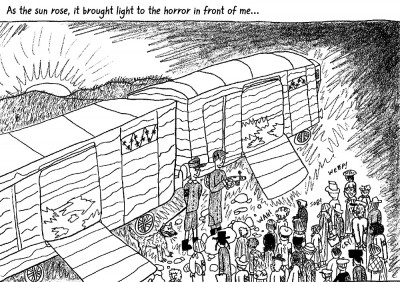By Dikla Tuchman, JTNews Correspondent
Christopher Huh is not Jewish. He has no European heritage and he’s not even old enough to drive.
But like thousands of other non-Jewish young people over the last 70 years, Huh, a 14-year-old Korean-American, became deeply affected by the historical account of the Holocaust.
As he sat in his 7th-grade class at Rocky Hill Middle School in Clarksburg, Md. and absorbed the overwhelming information from his teacher, he knew that sitting idly by while the rest of his peers appeared unaffected was not an option. So he went home, started digging deeper into the stories and the wealth of information on the Holocaust, and began to draw. His story developed into “Keeping My Hope,” a complex and beautiful narrative about an individual’s struggle in Poland during the war.
The 170-page graphic novel gives readers a meticulous account of Ari Kolodiejski and his family, as their small town in Poland transforms from a carefree village to a ghetto. Huh chooses to tell the story through the eyes of a grandfather passing on his tragic experience to his grandchildren.
“When I first decided to write the book, I thought the best way for people to learn was through a grandpa’s point-of-view,” says Huh. “I always liked it when I get to listen to my grandparents talk.”
Through his research, Huh decided to set his story in Poland, as it had the biggest Jewish population before World War II broke out. The detail that Huh puts into painting an accurate picture of pre-war Poland and then each stage of the war’s progression draws the reader in completely.
“I thought that this book should not only be a good story, but also be an opportunity for people to learn. Every little detail, I thought, should be something that spoke out,” says Huh. From towns to battles, from names to actual events and people, Huh wanted to be sure that everything in his novel was historically accurate.
“It was painstakingly difficult, but it was worth it,” he said. “I also asked my teacher, who is fluent in German, to double-check my translation.”
Huh read other Holocaust-related novels, such as “The Diary of Anne Frank,” Elie Wiesel’s “Night,” and Hans Peter Richter’s “Friedrich,” becoming well versed in the genre. Before launching into his own graphic novel, his teacher introduced him to Art Spiegelman’s “Maus,” the award-winning and most recognized Holocaust graphic novel. With all of this research under his belt, Huh set out to shape his own story to share with the world.
From his home in Maryland to as far as Israel, the community response to Huh’s self-published work has been incredible. Huh even received a letter from Elie Wiesel this month, praising his effort.
“Many people love the fact that I published this,” says Huh. “My schoolmates and teachers support me, along with my family, of course.”
As the story evolves, Huh goes into vivid detail as to Ari’s experience not only living in the ghetto, but also his transportation to and years living in Auschwitz. “The most important message in my book is that racism and prejudice are humanity’s greatest enemies and that we should always be aware of that,” says Huh. “It is explained on page 91, in the first speech bubble when Ari shows his number to his grandchildren.”
Through writing and illustrating “Keeping My Hope,” Huh has discovered his passion for both writing and drawing and plans to continue both in future.
You can find out more about “Keeping My Hope” and Christopher Huh at keepingmyhope.com. The graphic novel is available for purchase through Amazon.com and Barnes & Noble.
